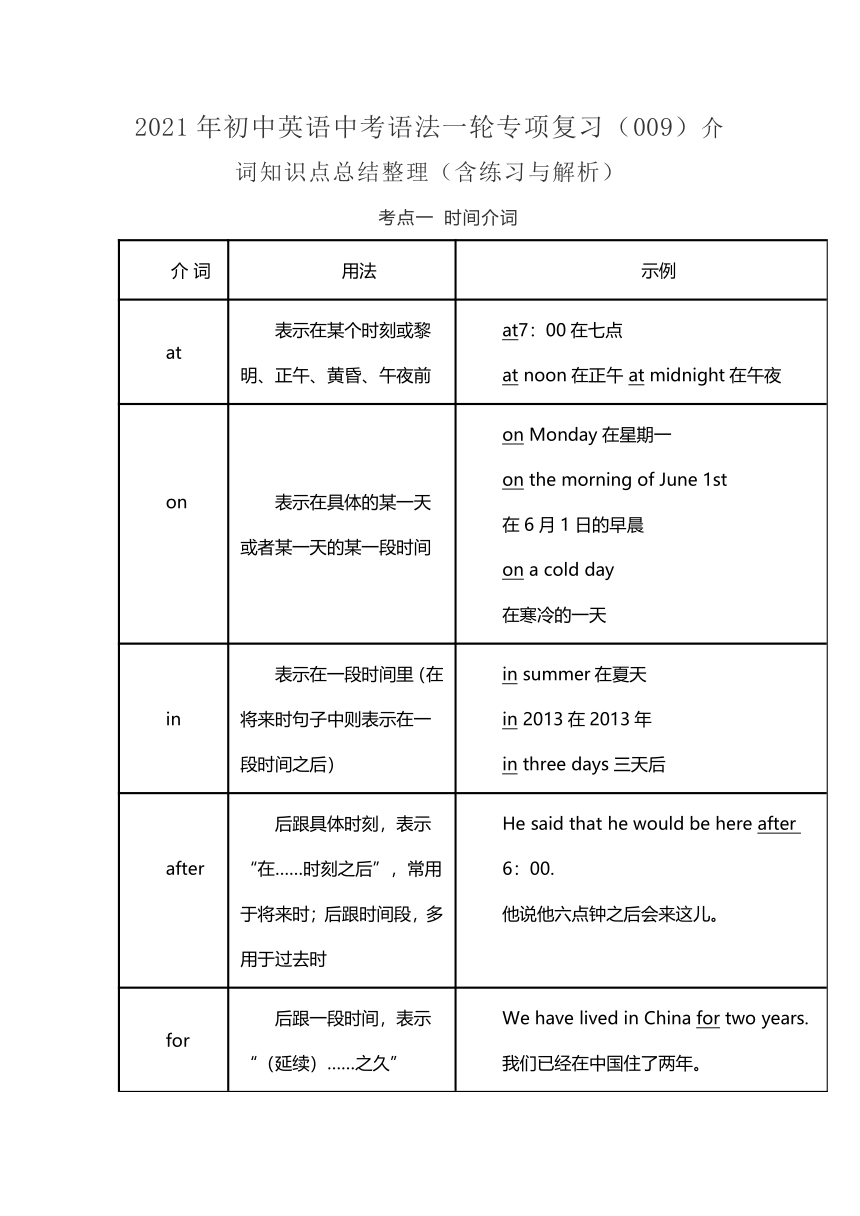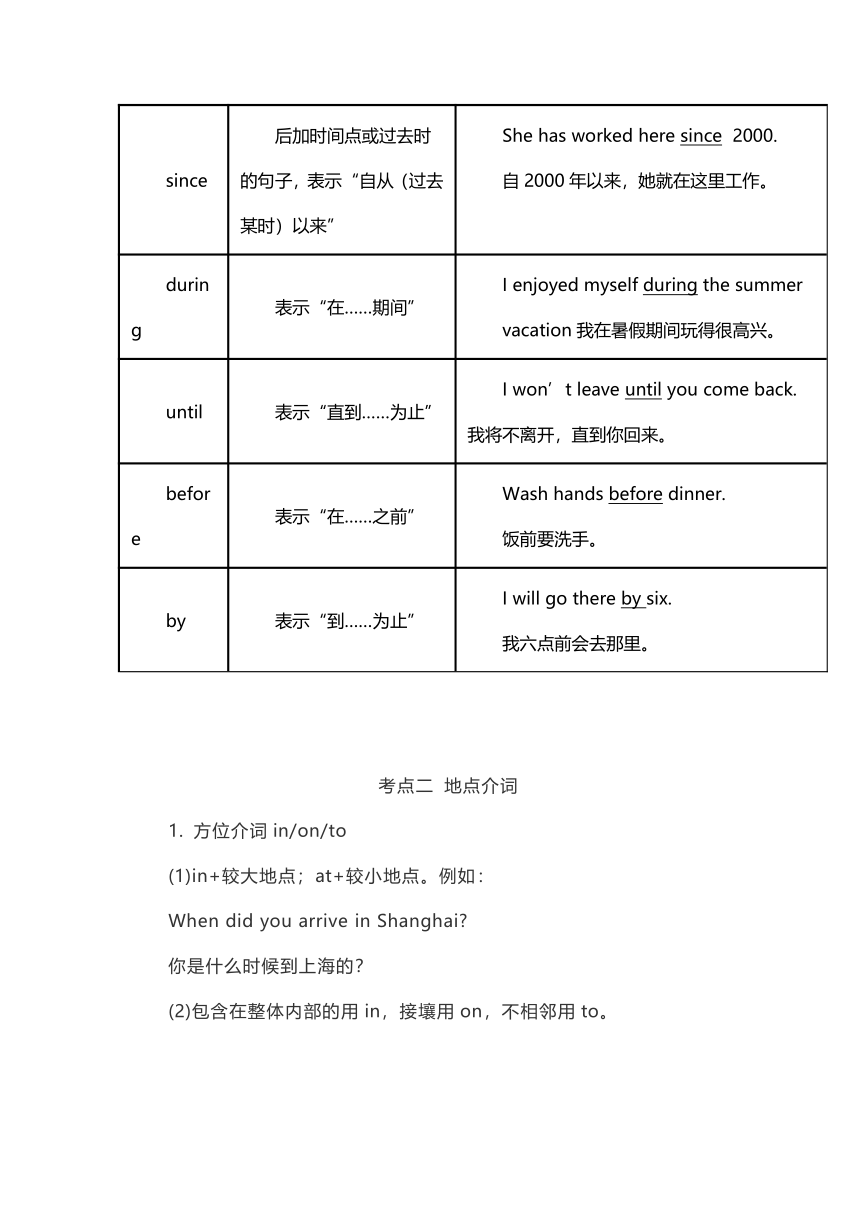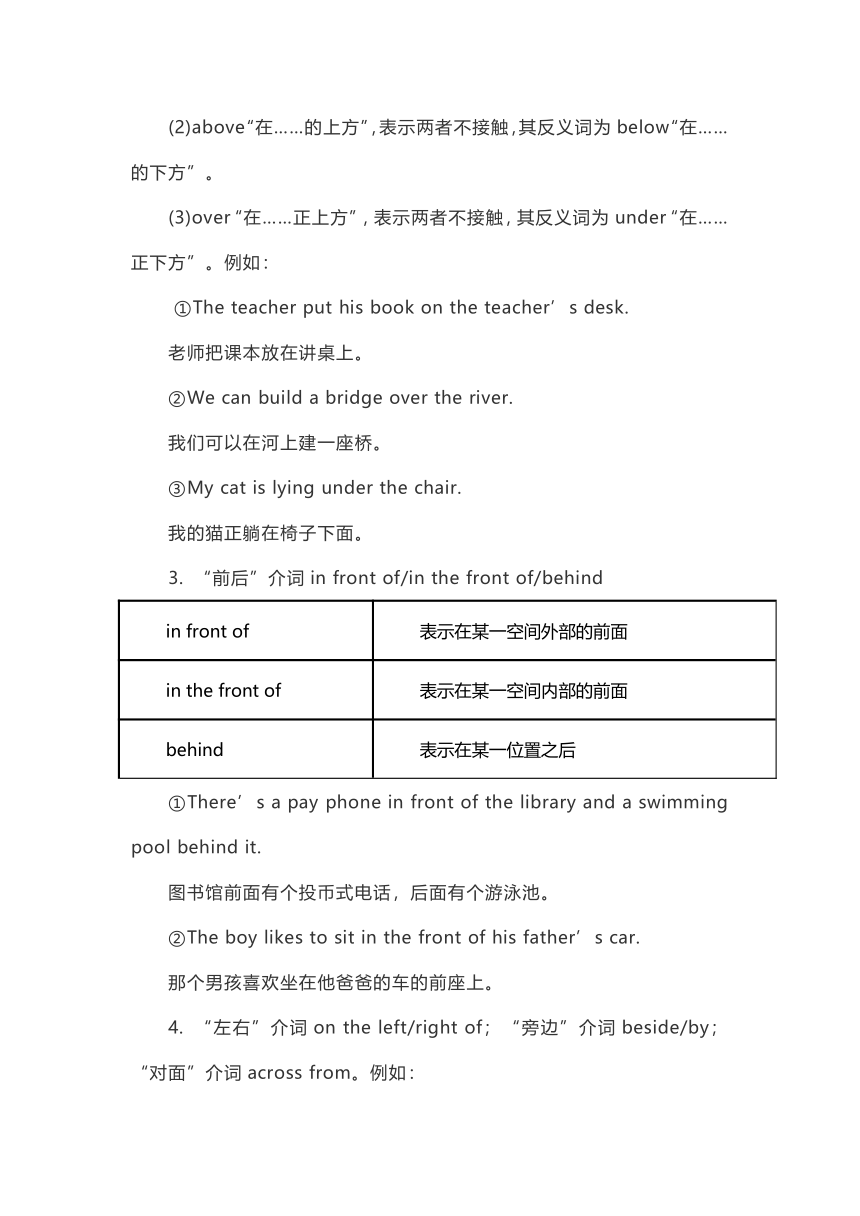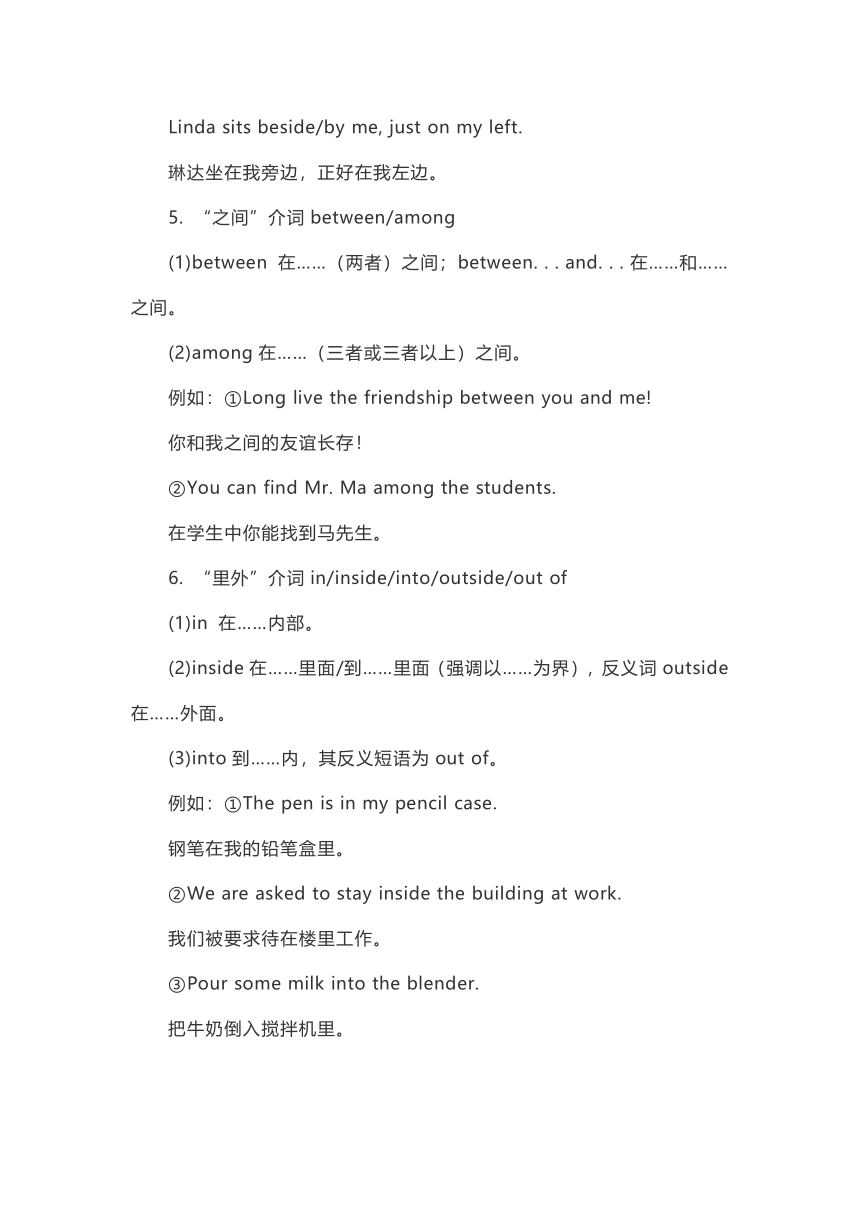2020年初中英语中考语法一轮专项复习(09)介词知识点总结整理(含练习与解析)
文档属性
| 名称 | 2020年初中英语中考语法一轮专项复习(09)介词知识点总结整理(含练习与解析) |  | |
| 格式 | docx | ||
| 文件大小 | 50.3KB | ||
| 资源类型 | 教案 | ||
| 版本资源 | 人教新目标(Go for it)版 | ||
| 科目 | 英语 | ||
| 更新时间 | 2020-12-07 21:18:37 | ||
图片预览





文档简介
10172700120904002021年初中英语中考语法一轮专项复习(009)介词知识点总结整理(含练习与解析)
考点一 时间介词
介?词
用法
示例
at
表示在某个时刻或黎明、正午、黄昏、午夜前
at7:00在七点
at?noon在正午?at?midnight在午夜
on
?
表示在具体的某一天或者某一天的某一段时间
on?Monday在星期一
on?the?morning?of?June?1st
在6月1日的早晨
on?a?cold?day
在寒冷的一天
in
表示在一段时间里(在将来时句子中则表示在一段时间之后)
in?summer在夏天
in?2013在2013年
in?three?days三天后
after
?
后跟具体时刻,表示“在……时刻之后”,常用于将来时;后跟时间段,多用于过去时
He?said?that?he?would?be?here?after?
6:00.?
他说他六点钟之后会来这儿。
for
后跟一段时间,表示“(延续)……之久”
We?have?lived?in?China?for?two?years.?
我们已经在中国住了两年。
since
后加时间点或过去时的句子,表示“自从(过去某时)以来”
She?has?worked?here?since??2000.?
自2000年以来,她就在这里工作。
during
表示“在……期间”
I?enjoyed?myself?during?the?summer?
vacation我在暑假期间玩得很高兴。
until
表示“直到……为止”
I?won’t?leave?until?you?come?back.?我将不离开,直到你回来。
before
表示“在……之前”
Wash?hands?before?dinner.?
饭前要洗手。
by
表示“到……为止”
I?will?go?there?by?six.?
我六点前会去那里。
考点二 地点介词
1. 方位介词in/on/to
(1)in+较大地点;at+较小地点。例如:
When did you arrive in Shanghai?
你是什么时候到上海的?
(2)包含在整体内部的用in,接壤用on,不相邻用to。
00
B is in the east of A.?
C is on the east of A.
D is to the east of A.
例如:
①Shandong is in the east of China.
山东在中国的东部。
②Jiangxi is on the east of Hunan.
江西在湖南的东部。
③Shanghai is to the east of Hubei.
上海在湖北的东部。
2. “上下”介词on/above/over/below/under
(1)on“在……上面”,表示两者接触。
(2)above“在……的上方”,表示两者不接触,其反义词为below“在……的下方”。
(3)over“在……正上方”,表示两者不接触,其反义词为under“在……正下方”。例如:
?①The teacher put his book on the teacher’s desk.
老师把课本放在讲桌上。
②We can build a bridge over the river.
我们可以在河上建一座桥。
③My cat is lying under the chair.
我的猫正躺在椅子下面。
3. “前后”介词in front of/in the front of/behind
in?front?of
表示在某一空间外部的前面
in?the?front?of
表示在某一空间内部的前面
behind
表示在某一位置之后
①There’s a pay phone in front of the library and a swimming pool behind it.
图书馆前面有个投币式电话,后面有个游泳池。
②The boy likes to sit in the front of his father’s car.
那个男孩喜欢坐在他爸爸的车的前座上。
4. “左右”介词on the left/right of;“旁边”介词beside/by;“对面”介词across from。例如:
Linda sits beside/by me, just on my left.
琳达坐在我旁边,正好在我左边。
5. “之间”介词between/among
(1)between 在……(两者)之间;between. . . and. . .?在……和……之间。
(2)among在……(三者或三者以上)之间。
例如:①Long live the friendship between you and me!
你和我之间的友谊长存!
②You can find Mr. Ma among the students.
在学生中你能找到马先生。
6. “里外”介词in/inside/into/outside/out of
(1)in 在……内部。
(2)inside在……里面/到……里面(强调以……为界),反义词outside在……外面。
(3)into到……内,其反义短语为out of。
例如:①The pen is in my pencil case.
钢笔在我的铅笔盒里。
②We are asked to stay inside the building at work.
我们被要求待在楼里工作。
③Pour some milk into the blender.
把牛奶倒入搅拌机里。
考点三 ?方式、手段、工具等介词
介?词
用法
例句
by
by+表示交通工具的名词
He?goes?to?school?by?bike.?
他骑自行车去上学。
by+?v.?-ing形式,表示“通过……方式”
He?learns?English?by?listening?to?the?radio.?
他通过听收音机学英语。
in
in+语言类名词或工具的具体类型
Please?say?it?in?Chinese.?请用汉语说它。
Don’t?write?in?pencil.?不要用铅笔写。
on
on+?radio/TV通过收音机/电视
He?listens?to?music?on?the?radio.?
他通过收音机听音乐。
with
表示“用”某种工具,身体的某一部位或器官
Cut?the?bag?with?the?knife.?
用刀子割开这个包。?
考点四 ?其他介词
介?词
用法
例?句
about
about多用于在内容和观点比较一般性的情况
What?is?your?excuse?about?your?being?
late??你关于迟到的借口是什么?
like
“像……一样”,说明相似关系,实际上不是
He?talked?to?me?like?my?father.?他像父亲那样跟我谈话。(他不是我父亲)
as
“作为以…的身份”,后跟表示职业、职务的名词
He?talked?to?me?as?a?father.?他以父亲的身份跟我说话。(他是我父亲)
介词
用法
例句
except
表示“除……之外”,从整体中除去一部分,含“减”的意思,属于否定形式
We?are?all?here?except?Li?Ming?because?he?is?ill.??除了李明,我们都在这里,因为他病了。
besides
表示“除……之外(还有,其余都相同)”,含有“加”的意思,属于肯定形式
This?time?we’ll?all?go?there?besides?Tom.???这次除了汤姆,我们也都将去那里。(意思是汤姆也去)
介词
用法
例句
with
表示伴随,意为“和……一起”
He?came?in?with?a?book?in?his?hand.?
他进来了,手里拿着一本书。
without
表示“没有”,用作状语
He?left?without?saying?a?word.?
他什么也没有说就离开了。
for
表示目的,意为“为了”
Let’s?go?for?a?walk.?
让我们去散散步吧。
中考英语语法专项复习介词专练
1. I go to school _____ bus every morning.
A. in
B. on
C. at
D. by
2. I like going to school ?_____ my bike.
A. in
B. on
C. by
D. at
3. I wrote _____ my brother last Saturday, but I haven’t heard _____ him up to now.
A. from; to
B. to; of
C. to; to
D. to; from
4. Shanghai Disneyland has started to be built and it will be open _____ five years.
A. in
B. for
C. from
D. before
5. John is standing _____ Gina and Jim.
A. at
B. during
C. between
D. in
6. —Your sweater looks very nice. What’s it made _____?
—Wool, and it is made ?_____ Guiyang.
A.?from; on
B.?B. of; in
C.?C. of; on
D.?D. from; in
7. —How do you learn English words?
— ?_____ making flashcards.
A.?To
B.?B. By
C.?C. For
D.?D. With
8. The moonlight goes _____ the window and makes the room bright.
A. across
B. through
C. over
D. in
9. ?I don’t know how to begin a talk with Betty. She can sit all day long ?_____ a word.
A. by
B. with
C. in
D. without
10. The two kids practice spoken English _____ ?joining the English club.
A. by
B. in
C. on
D. with
?
?
1.【解析】选D。by +?交通工具,表示“乘坐……”,且by与交通工具之间不加限定词。此外如用介词on应该加上冠词the,即“on the bus”。故选D。
2.【解析】选B。当交通工具类名词bike被限定词修饰时,不用by修饰,用介词on,故选B。
3.【解析】选D。write to sb.?给某人写信;hear from sb.?收到某人的来信。故选D。
4.【解析】选A。“in+一段时间”用于一般将来时。
5.【解析】选C。在两者之间要用介词between,between. . . and为固定搭配。故选C。
6.【解析】选B。be made of其后跟可以看得出的原材料“be made in+地点”表示“由某地制造”。
7.【解析】选B。“by+ v-ing”表示通过某种方式。
8.【解析】选B。句意:月光穿过窗户并使房间明亮。across是从事物的表面穿过;through是从物体的内部穿过;over强调从上面越过。故选B。
9.【解析】选D。本题考查介词辨析。by被;经由;with用;和……在一起;in在……内;without没有。without a word没说一句话。故选D。
10.【解析】选A。句意:这两个孩子通过加入英语俱乐部来练习英语。by意为“通过”,表示方式。故选A。
考点一 时间介词
介?词
用法
示例
at
表示在某个时刻或黎明、正午、黄昏、午夜前
at7:00在七点
at?noon在正午?at?midnight在午夜
on
?
表示在具体的某一天或者某一天的某一段时间
on?Monday在星期一
on?the?morning?of?June?1st
在6月1日的早晨
on?a?cold?day
在寒冷的一天
in
表示在一段时间里(在将来时句子中则表示在一段时间之后)
in?summer在夏天
in?2013在2013年
in?three?days三天后
after
?
后跟具体时刻,表示“在……时刻之后”,常用于将来时;后跟时间段,多用于过去时
He?said?that?he?would?be?here?after?
6:00.?
他说他六点钟之后会来这儿。
for
后跟一段时间,表示“(延续)……之久”
We?have?lived?in?China?for?two?years.?
我们已经在中国住了两年。
since
后加时间点或过去时的句子,表示“自从(过去某时)以来”
She?has?worked?here?since??2000.?
自2000年以来,她就在这里工作。
during
表示“在……期间”
I?enjoyed?myself?during?the?summer?
vacation我在暑假期间玩得很高兴。
until
表示“直到……为止”
I?won’t?leave?until?you?come?back.?我将不离开,直到你回来。
before
表示“在……之前”
Wash?hands?before?dinner.?
饭前要洗手。
by
表示“到……为止”
I?will?go?there?by?six.?
我六点前会去那里。
考点二 地点介词
1. 方位介词in/on/to
(1)in+较大地点;at+较小地点。例如:
When did you arrive in Shanghai?
你是什么时候到上海的?
(2)包含在整体内部的用in,接壤用on,不相邻用to。
00
B is in the east of A.?
C is on the east of A.
D is to the east of A.
例如:
①Shandong is in the east of China.
山东在中国的东部。
②Jiangxi is on the east of Hunan.
江西在湖南的东部。
③Shanghai is to the east of Hubei.
上海在湖北的东部。
2. “上下”介词on/above/over/below/under
(1)on“在……上面”,表示两者接触。
(2)above“在……的上方”,表示两者不接触,其反义词为below“在……的下方”。
(3)over“在……正上方”,表示两者不接触,其反义词为under“在……正下方”。例如:
?①The teacher put his book on the teacher’s desk.
老师把课本放在讲桌上。
②We can build a bridge over the river.
我们可以在河上建一座桥。
③My cat is lying under the chair.
我的猫正躺在椅子下面。
3. “前后”介词in front of/in the front of/behind
in?front?of
表示在某一空间外部的前面
in?the?front?of
表示在某一空间内部的前面
behind
表示在某一位置之后
①There’s a pay phone in front of the library and a swimming pool behind it.
图书馆前面有个投币式电话,后面有个游泳池。
②The boy likes to sit in the front of his father’s car.
那个男孩喜欢坐在他爸爸的车的前座上。
4. “左右”介词on the left/right of;“旁边”介词beside/by;“对面”介词across from。例如:
Linda sits beside/by me, just on my left.
琳达坐在我旁边,正好在我左边。
5. “之间”介词between/among
(1)between 在……(两者)之间;between. . . and. . .?在……和……之间。
(2)among在……(三者或三者以上)之间。
例如:①Long live the friendship between you and me!
你和我之间的友谊长存!
②You can find Mr. Ma among the students.
在学生中你能找到马先生。
6. “里外”介词in/inside/into/outside/out of
(1)in 在……内部。
(2)inside在……里面/到……里面(强调以……为界),反义词outside在……外面。
(3)into到……内,其反义短语为out of。
例如:①The pen is in my pencil case.
钢笔在我的铅笔盒里。
②We are asked to stay inside the building at work.
我们被要求待在楼里工作。
③Pour some milk into the blender.
把牛奶倒入搅拌机里。
考点三 ?方式、手段、工具等介词
介?词
用法
例句
by
by+表示交通工具的名词
He?goes?to?school?by?bike.?
他骑自行车去上学。
by+?v.?-ing形式,表示“通过……方式”
He?learns?English?by?listening?to?the?radio.?
他通过听收音机学英语。
in
in+语言类名词或工具的具体类型
Please?say?it?in?Chinese.?请用汉语说它。
Don’t?write?in?pencil.?不要用铅笔写。
on
on+?radio/TV通过收音机/电视
He?listens?to?music?on?the?radio.?
他通过收音机听音乐。
with
表示“用”某种工具,身体的某一部位或器官
Cut?the?bag?with?the?knife.?
用刀子割开这个包。?
考点四 ?其他介词
介?词
用法
例?句
about
about多用于在内容和观点比较一般性的情况
What?is?your?excuse?about?your?being?
late??你关于迟到的借口是什么?
like
“像……一样”,说明相似关系,实际上不是
He?talked?to?me?like?my?father.?他像父亲那样跟我谈话。(他不是我父亲)
as
“作为以…的身份”,后跟表示职业、职务的名词
He?talked?to?me?as?a?father.?他以父亲的身份跟我说话。(他是我父亲)
介词
用法
例句
except
表示“除……之外”,从整体中除去一部分,含“减”的意思,属于否定形式
We?are?all?here?except?Li?Ming?because?he?is?ill.??除了李明,我们都在这里,因为他病了。
besides
表示“除……之外(还有,其余都相同)”,含有“加”的意思,属于肯定形式
This?time?we’ll?all?go?there?besides?Tom.???这次除了汤姆,我们也都将去那里。(意思是汤姆也去)
介词
用法
例句
with
表示伴随,意为“和……一起”
He?came?in?with?a?book?in?his?hand.?
他进来了,手里拿着一本书。
without
表示“没有”,用作状语
He?left?without?saying?a?word.?
他什么也没有说就离开了。
for
表示目的,意为“为了”
Let’s?go?for?a?walk.?
让我们去散散步吧。
中考英语语法专项复习介词专练
1. I go to school _____ bus every morning.
A. in
B. on
C. at
D. by
2. I like going to school ?_____ my bike.
A. in
B. on
C. by
D. at
3. I wrote _____ my brother last Saturday, but I haven’t heard _____ him up to now.
A. from; to
B. to; of
C. to; to
D. to; from
4. Shanghai Disneyland has started to be built and it will be open _____ five years.
A. in
B. for
C. from
D. before
5. John is standing _____ Gina and Jim.
A. at
B. during
C. between
D. in
6. —Your sweater looks very nice. What’s it made _____?
—Wool, and it is made ?_____ Guiyang.
A.?from; on
B.?B. of; in
C.?C. of; on
D.?D. from; in
7. —How do you learn English words?
— ?_____ making flashcards.
A.?To
B.?B. By
C.?C. For
D.?D. With
8. The moonlight goes _____ the window and makes the room bright.
A. across
B. through
C. over
D. in
9. ?I don’t know how to begin a talk with Betty. She can sit all day long ?_____ a word.
A. by
B. with
C. in
D. without
10. The two kids practice spoken English _____ ?joining the English club.
A. by
B. in
C. on
D. with
?
?
1.【解析】选D。by +?交通工具,表示“乘坐……”,且by与交通工具之间不加限定词。此外如用介词on应该加上冠词the,即“on the bus”。故选D。
2.【解析】选B。当交通工具类名词bike被限定词修饰时,不用by修饰,用介词on,故选B。
3.【解析】选D。write to sb.?给某人写信;hear from sb.?收到某人的来信。故选D。
4.【解析】选A。“in+一段时间”用于一般将来时。
5.【解析】选C。在两者之间要用介词between,between. . . and为固定搭配。故选C。
6.【解析】选B。be made of其后跟可以看得出的原材料“be made in+地点”表示“由某地制造”。
7.【解析】选B。“by+ v-ing”表示通过某种方式。
8.【解析】选B。句意:月光穿过窗户并使房间明亮。across是从事物的表面穿过;through是从物体的内部穿过;over强调从上面越过。故选B。
9.【解析】选D。本题考查介词辨析。by被;经由;with用;和……在一起;in在……内;without没有。without a word没说一句话。故选D。
10.【解析】选A。句意:这两个孩子通过加入英语俱乐部来练习英语。by意为“通过”,表示方式。故选A。
同课章节目录
- 词法
- 名词
- 动词和动词短语
- 动词语态
- 动词时态
- 助动词和情态动词
- 非谓语动词
- 冠词
- 代词
- 数词和量词
- 形容词副词及其比较等级
- 介词和介词短语
- 连词和感叹词
- 构词法
- 相似、相近词比较
- 句法
- 陈述句
- 一般疑问句和否定疑问句
- 特殊疑问句及选择疑问句
- 反意疑问句
- 存在句(There be句型)
- 宾语从句
- 定语从句
- 状语从句
- 主谓一致问题
- 简单句
- 并列句
- 复合句
- 主谓一致
- 主、表语从句
- 名词性从句
- 直接引语和间接引语
- 虚拟语气
- 感叹句
- 强调句
- 倒装句
- 祈使句
- 句子的成分
- 句子的分类
- 题型专区
- 单项选择部分
- 易错题
- 完形填空
- 阅读理解
- 词汇练习
- 听说训练
- 句型转换
- 补全对话
- 短文改错
- 翻译
- 书面表达
- 任务型阅读
- 语法填空
- 其他资料
